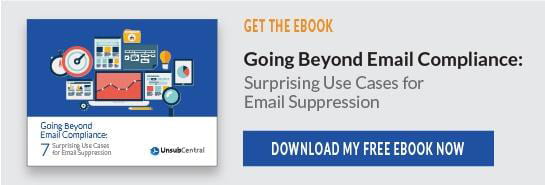Email suppression lists. You’ve got them covered, right? You already know, for example, about the various reasons to “suppress” or exclude a contact from your next email campaign—including:
Unqualified Status—Some leads simply don’t fit your marketing-qualified criteria.
Current Customers—There’s no reason your current customers should be receiving promotional emails from affiliates.
Geographic Factors—Some campaigns may be irrelevant or unavailable to a particular geography.
Strategic Issues—Many companies filter out competitors’ email addresses, making it harder for them to borrow ideas.
Unsubscribe Requests—And of course some leads are self-designated “opt outs,” contacts who have expressly requested you remove them from frequent mailings or from email altogether.
In this last case, the reasons behind email suppression lists are much less important than the mechanisms you use to honor opt-out requests. Believe it or not, some companies are still using spreadsheets. Some are using email compliance software that lacks easy integration and plug-ins for affiliates, which means email partners may be less likely to download suppression files or scrub their lists on a regular basis.
How confident are you that your brand is using the best solution to manage opt outs across all your different programs? If you’re anything less than positive, keep the following consequences in mind:
1. Getting Shamed on Twitter
Lots of prospects and customers now look for their favorite brands on Twitter. In fact, according to social media experts, nearly half of all monthly Twitter users (49 percent) use their accounts to follow brands or companies. Forty-two percent learn about products and services via Twitter, while 41 percent are offering (some rather candid) brand opinions.
So if you don’t have effective software in place—to generate and share suppression lists among your email partners—people may find your name alongside some unfortunate mentions…

2. Losing Customers (New and Old)
Think you can control your social media reputation with a vigilant customer support team and prompt resolutions? That may be true. But you still can’t address brand damage that’s happening offline.
According to a retail customer dissatisfaction study, only 6 percent of frustrated customers actually contact retailers with formal complaints. Meanwhile, 31 percent tell family and friends about their negative experiences (e.g. unwanted emails). As a result, 48 percent of those surveyed reported having avoided certain brands based on others’ negative experiences.
3. Incurring CAN-SPAM Fines
The FTC makes no bones about it: brands are obligated to honor opt-out requests promptly—even if the requests stem from an affiliate email campaign. You have 10 business days to ensure unsubscribes get added to your global suppression list (This CAN-SPAM provision includes B2B email, by the way.) Otherwise, each individual email in violation of the CAN-SPAM Act is subject to penalties of up to $16,000.
But hey, email suppression lists shouldn’t always be exercised out of fear. To learn more about the strategic uses of email suppression lists and suppression list software, take a look at our recent guide:
![]()

